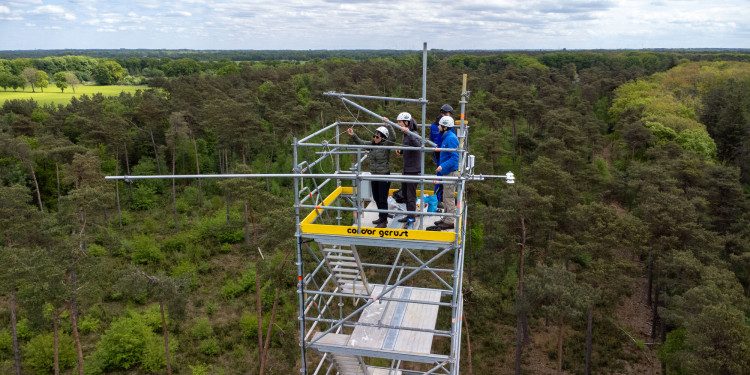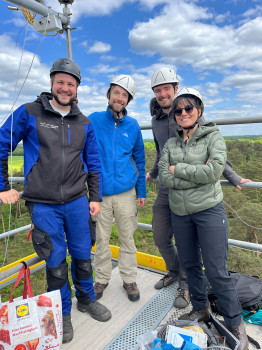
Climate research at lofty heights
It stands out even from a distance: the 30-metre-high tower, which attracts attention with its imposing height and four-square-metre platform accessible via 160 steps. The view from up there is breathtaking, offering a panoramic view of the extensive forest area. But the tower was not built for visitors to the forest to enjoy the beautiful view. On the contrary, it is closed to them. The numerous measuring instruments on the platform do not immediately reveal their purpose, but they are the heart of this special structure. More on that later.
Around 70 kilometres west of Münster, right on the border with the Netherlands, lies the Lünten Forest – a nature reserve covering around 110 hectares in the municipality of Vreden in the district of Borken. Only a few remnants of the former peatland and heathland have survived. Today, pine trees and a network of deep drainage ditches dominate the landscape. But this forest is facing a remarkable change. It is being prepared for climate protection and is going to be rewetted. The goal: step by step, the area is to be transformed back into a near-natural peatland forest.

Whether this transformation is actually successful and which environmental factors play a role in it is now to be investigated by the newly established laboratory in nature – a joint project of the "Landschaftsverband Westfalen-Lippe" (LWL) and the University of Münster. The tower has been in operation since May of this year and is expected to measure data continuously for the coming years. Under the scientific direction of Mana Gharun, the tower was designed and its location precisely planned. The climatologist is also responsible for installing measurements devices and evaluating the greenhouse gas fluxes. The so-called "Eddy covariance tower" will initially record data on the forest's greenhouse gas balance continuously for seven years – before, during and after rewetting.
The sensors record various greenhouse gases, such as carbon dioxide (CO₂) and water vapour, up to ten times per second. In addition, climate-relevant variables such as radiation, air and soil temperature, precipitation, heat flux and wind speed are measured. "These precise measurements, which are now in place before the renaturation process begins, enable us to accurately track the influences of rewetting on greenhouse gas fluxes," says Mana Gharun. "Our data enables us to make well-founded statements about the effectiveness of climate protection measures." Thanks to the advanced technical infrastructure, the research team in Münster can access and check the data remotely; if there are data gaps or inconsistencies, they can react immediately and resolve issues.
Students are also involved in the project from the beginning. They not only learn the theoretical aspects, but are also involved in the ongoing operation of the measurement setup, data collection and evaluation, for example as part of their final theses, study projects or as student assistants. In this way, they gain practical experience in natural sciences and in working with large, high-resolution data sets. In doing so, they use machine-learning methods for pattern recognition and modelling, for example. This practical training combines research and teaching and equips students with skills that are relevant to many areas of their professional life – from environmental monitoring to research and industrial applications.
The tower is not only a topic of conversation among the general public, but is also already a topic of discussion in the scientific community. "This station is connected to a global network for monitoring greenhouse gases. Through this network, we make freely accessible data available to the public, scientists from other disciplines and to politicians," reports Mana Gharun. In this way, the University of Münster enables the direct transfer of scientific knowledge to society.
Author: Kathrin Kottke
This article is from the University newspaper wissen|leben No. 6, 1 October 2025.
